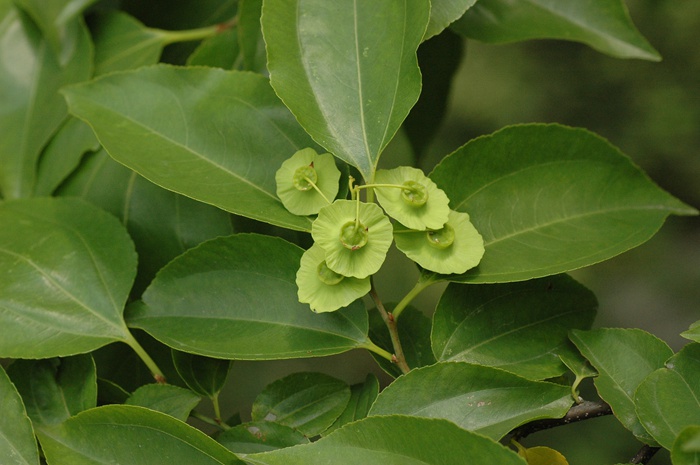- Scientific Name: Paliurus hemsleyanus Rehder
- Ref: J. Arnold Arbor. 12:74. 1931
- Chinese Common Name: 铜钱树 tóngqián∙shù
- Family: Rhamnaceae
- Genus: Paliurus
- Distribution: Mountain forests, often cultivated in gardens; below 1600 m. Anhui, Chongqing, Gansu, Guangdong, Guangxi, Guizhou, Henan, Hubei, Hunan, Jiangsu, Jiangxi, Shaanxi, Sichuan, Yunnan, Zhejiang.
- Photo: Gaoshancun, Zhejiang
Evergreen shrubs to medium-sized trees, to 20 m tall. Young branchlets, axillary buds, petioles, and major leaf venation ± densely brownish pubescent, flowers and fruit glabrous. Leaves alternate; petiole (6-)8-20 mm, glabrous or subglabrous, with 2 erect, stipular spines restricted to vegetative shoots; leaf blade broadly ovate to broadly elliptic, 4-12 × 3-9 cm, papery or thickly papery, both surfaces glabrous, 3-veined from base, base obtuse to rounded, often ± oblique, margin crenate or obtusely serrulate, apex acuminate to acute. Flowers glabrous, in cymes or cymose panicles, terminal or axillary together. Sepals triangular or broadly ovate, ca. 2 × 1.8 mm. Petals spatulate, ca. 1.8 × 1.2 mm. Stamens longer than petals. Disk pentagonous, 5-lobed. Ovary 3-loculed; style deeply 3-cleft. Drupe disk-shaped, comparatively large, 2-3.5 cm in diam., base conical, apex flattened; wing thinly papery to leathery; fruiting pedicel 1.2-1.5 cm. Fl. Apr-Jun, fr. Jul-Sep. (Flora of China)
